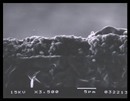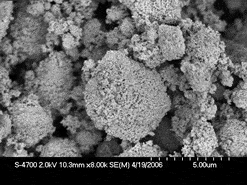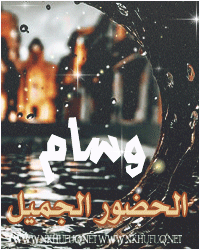Nanotechnology Information Center
منتـديات مكتـــوب الاستراتيجية للبحث العلمي MAKTOOB :: البــحـــــــث العـلـمــــــي :: رســـــائـل ماجستــــير و دكتــوراه البحــــث العلمــــــي و بـحـوث جـامعيـة جـاهــزة :: ابحاث نانو تكنولوجي Nano Technology
صفحة 1 من اصل 1
 Nanotechnology Information Center
Nanotechnology Information Center
Nanotechnology Information Center | ||||
What is Nanotechnology? | ||||
 Nanotechnology is a catch-all phrase for materials and devices that operate at the nanoscale. In the metric system of measurement, “Nano” equals a billionth and therefore a nanometer is one-billionth of a meter. References to nano materials, nanoelectronics, nano devices, nanofabrics, nanogels and nanopowders simply mean the material or activity can be measured in nanometers. To appreciate the size, a human red blood cell is over 2,000 nanometers long, virtually outside the nanoscale range! Nanotechnology is a catch-all phrase for materials and devices that operate at the nanoscale. In the metric system of measurement, “Nano” equals a billionth and therefore a nanometer is one-billionth of a meter. References to nano materials, nanoelectronics, nano devices, nanofabrics, nanogels and nanopowders simply mean the material or activity can be measured in nanometers. To appreciate the size, a human red blood cell is over 2,000 nanometers long, virtually outside the nanoscale range! | ||||
Recently, government and private institutions have devoted substantial research into finding potential valuable uses at this scale, as discussed below. | ||||
How are nanotechnologies used today? | ||||
Despite views that nanotechnology is a far-fetched idea with no near-term applications, nanoparticles, nanopowders and nanotubes already play a significant role in industry, environmental remediation, medicine, science and even in the household. A video on interesting new applications using nanoscale materials can also be watched on the new PBS NOVA series “Making Stuff: Smaller”. The majority of nanotechnologies commercially used today are based on such nano-sized particles. Rare earth nanoparticles and rare earth oxide nanopowders are finding application in uses as varied as enhanced fiber optic amplification (EDFA) to the removal of phosphate in the blood of patients with Hyperphosphatemia. Iron Nanoparticles, Iron Oxide Nanopowder, Cobalt Nanoparticles, and several other elemental nanoparticles and alloys form a group of "Magnetic Nanoparticles" with promising application in medical treatment of cancer, magnetic storage and magnetic resonance imaging (MRI). Rare earth nanoparticles and rare earth oxide nanopowders are finding application in uses as varied as enhanced fiber optic amplification (EDFA) to the removal of phosphate in the blood of patients with Hyperphosphatemia. Iron Nanoparticles, Iron Oxide Nanopowder, Cobalt Nanoparticles, and several other elemental nanoparticles and alloys form a group of "Magnetic Nanoparticles" with promising application in medical treatment of cancer, magnetic storage and magnetic resonance imaging (MRI). | ||||
Carbon Nanotubes are Single-Walled, Double Walled and Multi-Walled black nano scale cylindrical tubes of graphitic carbon with numerous applications. Carbon Nanotubes are the stiffest and strongest known fibers and have unique electrical properties. Applications for AE Carbon Nanotubes™ include in flat screen displays, scanning probe microscopes in brushes for commercial electric motors, and in sensing devices and because of their strength in numerous aerospace and automotive uses, in body armor and tear-resistant cloth fibers and textiles and stronger and lighter sports equipment . Carbon nanotubes can behave like a conductive metallic or semiconductor depending on their structure, which is useful for nanoscale electronic devices and in electrically conductive films in coatings, plastics, nanowire, nanofiber and in certain bioscience applications. Recently, carbon nanotubes have been demonstrated to create the "darkest" known material absorbing all wavelengths or "colors" of light which will prove useful in solar and electronic applications. Smart Yarns. Advances in carbon nanotube technologies are driving the generation of a new class of materials that cross the biomedical, textiles and electronics industries. From clothing to artificial muscles, it appears there is no end to the applications for this new generation of smart materials. Carbon nanotubes have the potential to radically change electronics and are among the most likely candidates for miniaturising electronic components beyond the micro-scale. But before nanotube circuits can be built, scientists first need to perfect the technology for attaching and welding nanotubes together. Graphene is a flat one-atom thick sheet of sp2 carbon atoms densely packed in a honeycomb crystal lattice structure. It is the basic structural element for graphite, carbon nanotubes, and fullerenes.Graphene samples are available as nanoflakes on Si/SiO2 substrate wafers. Each layer is monoatomically thin with a thickness of ~0.34nm, though it is possible to produce multi-layered flakes.  Using microscopic imagery, one can easily find the flakes and process them using microelectronic fabrications techniques. Using microscopic imagery, one can easily find the flakes and process them using microelectronic fabrications techniques.Graphene is the first example of truly two-dimensional crystals, giving it novel electronic and mechanical properties. Because of its high electronic mobility, structural flexibility, and capability of being tuned from p-type to n-type doping by the application of a gate voltage, graphene is considered a potential breakthrough in terms of carbon-based nano-electronics. Research into applications for carbon graphene nanosheets has focused on uses as platforms for next-wave microchips, active materials in field emitter arrays for flat panel screen displays, in biological sensors and medical imaging devices, in solar energy cells, and in high-surface area electrodes for use in bio-science. Graphene is a possible replacement material where carbon nanotubes are presently used. Surface Functionalized Nanomaterials. Surface Functionalized Nanoparticles such as Dodecanethiol Functionalized Gold Nanoparticles have controlled surface chemistries which can provide  novel methods to change the adhesion (wetting) properties of the particles, re-order their interfacial region or enhance the dispersion properties of the nanopowder in polymers, plastics and coatings for improved magnetic, fluorescent, dielectric, and catalytic properties. Surface Functionalized Nanoparticles have particular application in LEDs, drug delivery systems, sensors and electronics. novel methods to change the adhesion (wetting) properties of the particles, re-order their interfacial region or enhance the dispersion properties of the nanopowder in polymers, plastics and coatings for improved magnetic, fluorescent, dielectric, and catalytic properties. Surface Functionalized Nanoparticles have particular application in LEDs, drug delivery systems, sensors and electronics.Nanomedicine. The biomedical field is manufacturing artificial bone composites from nanocrystalline calcium phosphates. These composites are made of the same mineral as natural bone, yet have strength in compression equal to stainless steel. Silicon Nanoparticles have been shown to dramatically expand the storage capacity of lithium ion batteries without degrading the silicon during the expansion/contraction cycle that occurs as power is charged and discharged. Silicon has long been known to have an excellent affinity for storage of positively charged lithium cations making them ideal candidates for next generation lithium ion batteries. However, the quick degradation of silicon storage units has made them commercially unfeasible for most applications. Silicon Nanowires however, cycle without significant degradation and present the potential for use in batteries with greatly expanded storage times.Carbon Nanohorns provide a unique combination of strength, electrical conductivity, high surface area and open gas paths making them an ideal next generation electrode for various fuel cell applications. Nanotechnology is playing an increasing role in solving the world energy crisis. Platinum nanoparticles produced and marketed under the trade name P-Mite are ideal candidates as a novel technology for low platinum automotive catalysts and for single-nanotechnology research. Lanthanum Nanoparticles, Cerium nanoparticles, Strontium Carbonate Nanoparticles, Manganese Nanoparticles, Manganese Oxide Nanopowder, Nickel Oxide Nanopowder and several other nanoparticles are finding application in the development of small cost-effective Solid Oxide Fuel Cells (SOFC). And Platinum Nanoparticlesare being used to develop small Proton Exchange Membrane Fuel Cells (PEM). Lithium Nanoparticles, Lithium Titanate Nanoparticles and tantalum nanoparticles will be found in next generation lithium ion batteries. Ultra high purity Silicon Nanoparticles are being used in new forms of solar energy cells. Thin film deposition of Silicon Nanoparticle quantum dots on the polycrystalline silicon substrate of a photovoltaic (solar) cell increases voltage output as much as 60% by fluorescing the incoming light prior to capture. | ||||
By narrowly controlling the particles distribution (PSD) of quantum dot nanocrystals to within 10 nanometers, discreet colors with long term photostability can be emitted with wave lengths representing the entire visible spectra. This ability has found application in fluorescent biomarkers and dyes for live cell imaging and antibody conjugates. Additionally, prior to quantum dots, light emitting semiconductors, such as light emitting diodes (LED), could not emit white light. With the development of quantum dots with particle size distributions less than 500 nanometers (nm), LED emissions in the blue range can be achieved which may allow for the commercial use of solid state semiconductors to generate luminescent light. | ||||
Nanoscale Z-MITE™ ZnO is being used for its UV absorbing properties to create transparent sunscreen. The particles' small size makes them invisible to the naked eye, so the lotion is clear. At American Elements, we produce nanoscale oxides for a wide variety of applications. For detailed product information on the uses and applications of Z-MITE™, see Z-MITE™ PRODUCT INFORMATION. Z-MITE™ Zinc Oxide nanoparticles , zinc nanoparticles and silver nanoparticles , are used for many applications, including as an anti-microbial, anti-bacterial, anti-biotic and anti-fungal agents when incorporated in coatings, fibers, polymers, first aid bandages, plastics, soap and textiles. | ||||
 | Nanoscale gas path and electronically conductive bridging structures made from American Elements’ advanced ceramic materials. | |||
Like Carbon Nanotubes, Silicon Dioxide Nanoparticles, Silicon Nanoparticles, Copper Nanoparticles, Copper Oxide Nanoparticles, Indium Nanoparticles and many others are either superconductors, electrical conductors or semiconductor particles, or quantum dots with far reaching potential in electronics, high speed computing, telecommunication and space travel. | ||||
Nanocomposites are also seeing commercial use. Plastic nanocomposites are used for strong, lighter, and rust-proof car components. Toyota recently began using nanocomposites in bumpers that makes them 60% lighter and twice as resistant to denting and scratching. | ||||
| For a given amount of material, as particle size decreases, surface area increases. American Elements nanoscale cerium oxide nanoparticles, platinum nanoparticles, gold nanoparticles, palladium nanoparticles, molybdenum nanoparticles, nickel nanoparticles and iridium nanoparticles have extremely high surface area, and have thereby found important uses in catalysts for a whole host of chemical synthesis, chemical treatment and chemical cracking applications, including automotive catalytic converters, where surface areas on our materials can reach over 200 m2 /gram. | ||||
| Also like carbon nanotubes, Silicon Nanotubes and Nanocomposites such as boron carbide nanoparticles, silicon carbide nanoparticles and titanium carbide nanopaorticles are also seeing commercial use due their great strength. Plastic nanocomposites are used for strong, lighter, and rust-proof car components. Toyota recently began using nanocomposites in bumpers that makes them 60% lighter and twice as resistant to denting and scratching. The biomedical and bio-science fields have found near limitless uses for nanoparticles. Nanoparticles made of peroxalate ester polymers with a fluorescent dye (pentacene) encapsulated into the polymer have been found to be capable of detecting cancer. This is due to the fact that hydrogen peroxide is generated in human cells that are pre-cancerous. The dye in the nanoparticles fluoresces when they come in contact with the hydrogen peroxide which can then be detected as light on medical imaging equipment. Artificial bone composites are now being manufactured from calcium phosphate nanocrystals. These composites are made of the same mineral as natural bone, yet have strength in compression equal to stainless steel. Tungsten Oxide Nanoparticles are being used in dental imaging because they are sufficiently radiopaque (impervious to radiation) for high quality X-ray resolution. The group of Magnetic Nanoparticles discussed above is being used to both kill cancer cells in malignant tumors and in MRI medical imaging. Coat tungsten particles with DNA and inject them into plant cells or plant embryos. Some genetic material will remain in the cells and transform them. This method allows transformation of plant plastids. The transformation efficiency is lower than in agro bacterial mediated transformation. The anti-bacterial and anti-microbial effects of many nanoparticles are well understood technology. Fluorescent nanoparticles are being used by biologists to stain and label cellular components. By changing the size of the quantum dot the color emitted can be controlled. With a single light source, one can see the entire range of visible colors, an advantage over traditional organic dyes. | ||||
| While there has been news of the possible environmental effects of nanotechnology, such as predictions of "gray goo" formation, to date Nanotechnology has been the source of several environmental clean up products. For example, Nickel Nanocrystals are a reagent for the dehalogenation of trichloroethylene (TCE) , a common groundwater environmental remediation contaminant. | ||||
| American Elements' 20nm Z-MITE™ nanopowder used to form ultra high surface area supra-micron macroparticles |  | |||
What is the history of Nanotechnology? | ||||
The scientific community generally attributes the first acknowledgement of the importance of the nanoscale range to the brilliant Nobel Laureate physicist Richard Feynman in his famous 1959 lecture "There's Plenty of Room at the Bottom" in which he first proposed that the properties of materials and devices at the nanometer range would present future opportunities. The term reached greater public awareness in 1986 with the publication of "Engines of Creation: The Coming Era of Nanotechnology" by Eric Drexler. | ||||
What is the future of Nanotechnology? | ||||
 Nanotechnology is expected to have an impact on nearly every industry. The U.S. National Science Foundation has predicted that the global market for nanotechnologies will reach $1 trillion or more within 20 years. The research community is actively pursuing hundreds of applications in nanomaterials, nanoelectronics, and bionanotechnology. Most near term (1-5 years) applications of nanotechnology are in the form of nanomaterials. These include materials such as lighter and stronger nanocomposites, antibacterial nanoparticles, and nanostructured catalysts. Nanodevices and nanoelectronics are farther off, perhaps 5-15 years, and will have applications in medical treatments and diagnostics, faster computers, and in sensors. Nanotechnology is expected to have an impact on nearly every industry. The U.S. National Science Foundation has predicted that the global market for nanotechnologies will reach $1 trillion or more within 20 years. The research community is actively pursuing hundreds of applications in nanomaterials, nanoelectronics, and bionanotechnology. Most near term (1-5 years) applications of nanotechnology are in the form of nanomaterials. These include materials such as lighter and stronger nanocomposites, antibacterial nanoparticles, and nanostructured catalysts. Nanodevices and nanoelectronics are farther off, perhaps 5-15 years, and will have applications in medical treatments and diagnostics, faster computers, and in sensors. | ||||
We are actively involved in pursuing promising research to develop equipment and procedures to manipulate single atoms or molecules with the goal of establishing a new class of man-made atomic structures constructed one molecule at a time. In addition, we support the industrial and academic research efforts by supplying the ultra-pure, advanced materials required to perform nanotechnology research. | ||||
What are the safety, hazard and public policy issues with Nanotechnology? | ||||
Numerous articles have recently been published warning of the dangers presented by unregulated nanotechnologies. The most fantastic of which is the threat of Gray Goo, a hypothesized substance resulting from the runaway dissolution of the earth by self-replicating nanobots. While many of these concerns seem less science than science fiction, the very scale range of these materials do present safety and environmental issues that should be addressed responsibly by industry at least in the same manner as fine particulate materials are currently handled under existing health and safety guidelines. | ||||
| ||||

ღ ღ ღ ღ ღ ღ ღ ღ
 ღ ღ ღ ღ ღ ღ ღ
ღ ღ ღ ღ ღ ღ ღ 

♕ فخآمة أوركيـد ♕- ♔ السمو الملكي ♔

- جائزه تسجيل للعام 10 اعوامتاج 100 موضوعجائزه عدد النقاطتاج المواضيعجائزه المواضيع امميزهعدد المشاركات بالمواضيع المميزهجائزه الاعجابات
- عدد الرسائل : 1176
العمل/الترفيه : ترى كل الفصول " اربع " .. وحبكـ فصلي ... الخـــامس .. !
الابراج :

الموقع : الحديث مع روح تحبها سعادة تغنيك عن الدنيا
احترام القانون :
المزاج : كليوباترا
نقاط : 21170
السٌّمعَة : 25
تاريخ التسجيل : 28/02/2008
تعاليق : جــالــسه ببحـالــي ولـحـالــي
هـزنــي الــشــوق وذكــرتــك
يعني معقولة يا غالي كل هذا وما وحشتك ؟؟
------------
الأهمية في البحث العلمي تعني القيمة والأثر الذي يمكن أن يحققه البحث العلمي
في حل المشكلات وتطوير المعرفة في مجال معين، و يتم تحقيق الأهمية من خلال
توفير إجابات واضحة ودقيقة للأسئلة البحثية، وتقديم حلول للتحديات العلمية والتكنولوجية المعقدة.







-

 مواضيع مماثلة
مواضيع مماثلة» [center]الصورة السورية لاستخبار آيزينك للشخصية[/center]
» [center]قبعات التفكير الست و نظم معالجة المعلومات[/center]
» [center]الصورة السورية لمقياس بيك للاكتئاب[/center]
» [center]الشباب والخروج من دائرة الادمان[/center]
» Nanotechnology
» [center]قبعات التفكير الست و نظم معالجة المعلومات[/center]
» [center]الصورة السورية لمقياس بيك للاكتئاب[/center]
» [center]الشباب والخروج من دائرة الادمان[/center]
» Nanotechnology
منتـديات مكتـــوب الاستراتيجية للبحث العلمي MAKTOOB :: البــحـــــــث العـلـمــــــي :: رســـــائـل ماجستــــير و دكتــوراه البحــــث العلمــــــي و بـحـوث جـامعيـة جـاهــزة :: ابحاث نانو تكنولوجي Nano Technology
صفحة 1 من اصل 1
صلاحيات هذا المنتدى:
لاتستطيع الرد على المواضيع في هذا المنتدى



